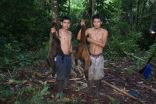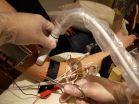(Press-News.org) There is evidence that hunter-gatherers are optimal foragers whose behaviour is influenced by costs associated with foraging, and therefore for example rising the costs of ammunition could potentially help conserving wild animals. However, there has been a paucity of studies on whether the behaviour of bushmeat hunters, like that of consumers, is cost sensitive moneywise.
In Ecuador, ammunition prices rose unexpectedly by 300 per cent in early 2009, because of a tax imposed by the national Government. This happened right when Anders Sirén, then postdoc researcher at the Pontificial Catholic University of Ecuador, and now lecturer at the Dept. of Geosciences and Geography at the University of Helsinki, Finland, was in the midst of conducting field research on the relation between wildlife hunting and habitat quality in Sarayaku, an indigenous community of above 1000 inhabitants in the tropical rainforests of Ecuadorian Amazonia.
Anders Sirén soon realized that he could take advantage of this situation in order to empirically test the impacts of the ammunition cost rise on hunting behaviour. The results, which were published in the latest issue of the Oryx journal, in an article authored by him together with David Wilkie of the US-based conservation organization Widllife Conservation Society, show that hunters adapted to the new circumstances in several ways.
Taxing gunshots is an effective conservation measure for small animals
After the rise of ammunition costs, bush meat hunters spent less time hunting, and hunted fewer kilograms of meat. In particular, the hunting of small animals decreased, whereas hunting of animals large enough to be worth more than the cost of a shotgun cartridge even after the imposition of the tax, decreased much less.
Some hunters, however, instead switched hunting technology, from cartridge shotguns to muzzle-loaders, which are less effective but have much cheaper ammunition, and these hunters thus continued hunting also small animals.
In sum, taxing gunshots was a much more effective conservation measure for small animals than for large ones, and unfortunately the large animals are typically the ones that are most severely threatened by the impacts of hunting. According to the authors, in order to promote conservation also of large animals, much higher taxes on gunshots would be needed than the 300 per cent tax imposed in Ecuador.
The authors warn for the potential negative short-term socio-economic consequences that such high taxing of ammunition could have for hunting-dependent households in forest regions. The authors nevertheless conclude that taxing gunshots seems to be a useful tool for conserving hunted wildlife species, but is not sufficient alone, and should be used in combination with other measures.
INFORMATION:
DSC09392: Sharply increased costs of ammunition led to just a slight decrease of the hunting of large animals such as these woolly monkeys.
(Photo: Eriberto Gualinga)
Oryx, The International Journal of Conservation, The effects of ammunition price on subsistence hunting in an Amazonian village
For more information, contact Anders Sirén, anders.siren@helsinki.fi, skype "anderssiren"
With regards,
Minna Meriläinen-Tenhu, Press Officer, University of Helsinki, minna.merilainen@helsinki.fi, +358 50 415 0316
Cost sensitive bushmeat hunters help out conservering hunted wildlife species
Hunting of bushmeat is 1 major cause of biodiversity loss in tropical countries
2014-10-08
ELSE PRESS RELEASES FROM THIS DATE:
Teenage girls are exposed to more stressors that increase depression risk
2014-10-08
Adolescence is often a turbulent time, and it is marked by substantially increased rates of depressive symptoms, especially among girls. New research indicates that this gender difference may be the result of girls' greater exposure to stressful interpersonal events, making them more likely to ruminate, and contributing to their risk of depression.
The findings are published in Clinical Psychological Science, a journal of the Association for Psychological Science.
"These findings draw our focus to the important role of stress as a potential causal factor in the development ...
Scientists identify method of eradicating harmful impacts from manufacturing process
2014-10-08
The human and environmental dangers posed by a widely used manufacturing technique could be almost eradicated thanks to research led by Plymouth University.
Fibre-reinforced polymer matrix composites are painted or sprayed onto products to provide a high-quality finish in transport applications, chemical plants, renewable energy systems and pipelines.
But that finishing process causes the vapours of a volatile organic compound – styrene, found in polyesters and vinyl-esters – to be emitted, posing potential health and wellbeing risks to the workforces involved ...
Smallest world record has 'endless possibilities' for bio-nanotechnology
2014-10-08
Scientists from the University of Leeds have taken a crucial step forward in bio-nanotechnology, a field that uses biology to develop new tools for science, technology and medicine.
The new study, published in print today in the journal Nano Letters, demonstrates how stable 'lipid membranes' – the thin 'skin' that surrounds all biological cells – can be applied to synthetic surfaces.
Importantly, the new technique can use these lipid membranes to 'draw' – akin to using them like a biological ink – with a resolution of 6 nanometres (6 billionths ...
Antarctic sea ice reaches new record maximum
2014-10-08
VIDEO:
The Arctic and the Antarctic are regions that have a lot of ice and acts as air conditioners for the Earth system. This year, Antarctic sea ice reached a record...
Click here for more information.
Sea ice surrounding Antarctica reached a new record high extent this year, covering more of the southern oceans than it has since scientists began a long-term satellite record to map sea ice extent in the late 1970s. The upward trend in the Antarctic, however, is only about ...
Neurons in human muscles emphasize the impact of the outside world
2014-10-08
Stretch sensors in our muscles participate in reflexes that serve the subconscious control of posture and movement. According to a new study published in the Journal of Neuroscience, these sensors respond weakly to muscle stretch caused by one's voluntary action, and most strongly to stretch that is imposed by external forces. The ability to reflect causality in this manner can facilitate appropriate reflex control and accurate self-perception.
"The results of the study show that stretch receptors in our muscles indicate more than which limb is moving or how fast; these ...
Treasure trove of ancient genomes helps recalibrate the human evolutionary clock
2014-10-08
Just like adjusting a watch, the key to accurately telling evolutionary time is based upon periodically calibrating against a gold standard.
Scientists have long used DNA data to develop molecular clocks that measure the rate at which DNA changes, i.e., accumulates mutations, as a premiere tool to peer into the past evolutionary timelines for the lineage of a given species. In human evolution, for example, molecular clocks, when combined with fossil evidence, have helped trace the time of the last common ancestor of chimpanzees and humans to 5-7 million years ago, and ...
Gluing chromosomes at the right place
2014-10-08
During cell division, chromosomes acquire a characteristic X-shape with the two DNA molecules (sister chromatids) linked at a central "connection region" that contains highly compacted DNA. It was unknown if rearrangements in this typical X-shape architecture could disrupt the correct separation of chromosomes. A recent study by Raquel Oliveira, from the Instituto Gulbenkian de Ciência (Portugal), in collaboration with colleagues from the University of California, Santa Cruz (USA), now shows that the dislocation of particular DNA segments perturbs proper chromosome ...
Fine-tuning of bitter taste receptors may be key to animal survival
2014-10-08
One key to animal survival is bitter taste----the better to avoid ingesting potentially harmful poisons or foods. The evolution of bitter taste has been a hot topic amongst evolutionary biologists, and with more and more DNA data available, a rich area of exploration.
Now, professor Maik Behrens, et. al. examined the genetic repertoire of bitter taste receptor genes in chickens and frogs, which represent two extremes. Chickens only have 3 bitter taste receptor genes (Tas2rs), while frogs have more than 50 (humans are somewhere in the middle). They studied the different ...
Dietary fat under fire
2014-10-08
This news release is available in French. The association between saturated fat and cardiovascular risk has become a hot topic in nutrition. Researchers at the Institute of nutrition and functional foods (INAF) of Université Laval are calling for a review of dietary recommendations on saturated fat (SFA) in relation to cardiovascular disease (CVD).
In a Comment paper, published today in the journal Applied Physiology, Nutrition, and Metabolism the authors provide a number of arguments for the urgency to re-assess the association between dietary saturated fat ...
Flies with colon cancer help to unravel the genetic keys to disease in humans
2014-10-08
Researchers at the Institute for Research in Biomedicine (IRB Barcelona) have managed to generate a fruit fly (Drosophila melanogaster) model that reproduces human colon cancer. With two publications appearing in PLoS One and EMBO Reports, the IRB team also unveil the function of a key gene in the development of the disease.
"The breakthrough is that we have generated cancer in an adult organism and from stem cells, thus reproducing what happens in most types of human cancer. This model has allowed us to identify subtle interactions in the development of cancer that are ...
LAST 30 PRESS RELEASES:
Short, light-intensity exercise boosts executive function and elevates mood in children
Jeonbuk National University researchers reveal new interface engineering strategy for efficient and stable back-contact solar cells
Tyrosinase drives hydroquinone-induced exogenous ochronosis: not HGD inhibition
UMass Amherst chemists develop unique tool for studying RNA
Disappointment alters brain chemistry and behavior
A built-in odometer: new study reveals how the brain measures distance
Stress-related brain signals drive risk of cardiovascular disease in people with depression and anxiety
New details on role of fat transport molecules in Alzheimer’s onset
Study illuminates how an antiviral defense mechanism may lead to Alzheimer’s disease
Spot the males: New gene-editing method could transform mosquito control
AI learns to build simple equations for complex systems
NAU team releases 13 years of detailed U.S. CO2 emissions data
Unveiling how sodium-ion batteries can charge faster than lithium-ion ones
How do childcare tax credits affect children’s long-term health?
Can an electronic nose detect indoor mold?
Do natural disasters have long-term impacts on mortality in older adults?
Modification improves sodium‐ion batteries as an alternative to lithium-ion batteries
Parasports provide a range of benefits for people with cerebral palsy
How does grandparental care affect children’s health?
Why are there so many Nordic mediators?
Young shark species more vulnerable to extinction
Mobile fetal heart monitoring linked to fewer newborn deaths in Tanzania
Bluey’s dad offered professorial chair in archaeology at Griffith University
Beyond small data limitations: Transfer learning-enabled framework for predicting mechanical properties of aluminum matrix composites
Unveiling non-thermal catalytic origin of direct current-promoted catalysis for energy-efficient transformation of greenhouse gases to valuable chemicals
Chronic breathlessness emerging as a hidden strain on hospitals
Paleontologists find first fossil bee nests made inside fossil bones
These fossils were the perfect home for ancient baby bees
Not everyone reads the room the same. A new study examines why.
New research identifies linked energy, immune and vascular changes in ME/CFS
[Press-News.org] Cost sensitive bushmeat hunters help out conservering hunted wildlife speciesHunting of bushmeat is 1 major cause of biodiversity loss in tropical countries




